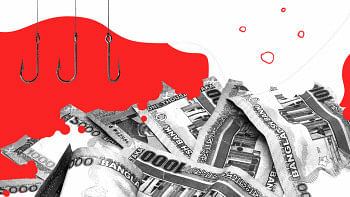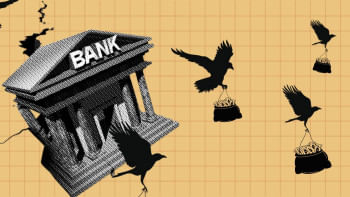Our rising foreign debt and financial worries

In September this year, the amount of Bangladesh's external debt exceeded $100 billion. Given that the country's GDP is $456 billion, the amount of external debt equals 22 percent of its GDP. In 2016, this amount was only $41 billion and equal to 16 percent of GDP. The country's foreign debt registered a growth of as high as 14 percent over the last six years, while annual GDP growth was 6.55 percent on average. The growth of debt exceeding the growth of GDP is a clear sign of vulnerability, the consequences of which are already present. Seventy percent of this debt burden was created in the last decade, during a period when Bangladesh's development was notable. But this obviously puts into question the method of financing development by borrowing funds from outside.
While politicians in power do not seem to consider this abnormal growth of foreign debt as a sign of weakness, the emerging threats to financial stability will be difficult to tackle when principal-plus-interest payments mount exponentially. The government must act now to put a break on the abnormal growth of debt, which can only be accomplished by getting our superrich to make more contributions to the coffers of taxes and duties. But the current regime's preparedness to make this happen seems to have gone backwards, as evidenced by the falling tax-GDP ratio over the last 10 years. Fiscal erosion of this kind is abnormal for any developing country.
Bangladesh's private sector now occupies a 21 percent share of the composition of the foreign debt. While the debt growth is good for private investors because of lower cost of funds, the loans would require more and more foreign currency as repayments keep rising over time. But Bangladesh's foreign exchange reserves have dwindled over the last two years. The government should investigate whether private borrowers who collected foreign currencies have really invested in domestic businesses or have misused them somehow. Concerns over the rise in both foreign borrowing and money laundering are worth addressing.
Although Bangladesh is not spending too much on expanding its military might, the country's debt effectiveness is one of the poorest in the world due to bureaucratic tentacles, inordinate delays in project implementation, and massive corruption in public-sector projects. And all this makes the rise in foreign debt a real concern for Bangladesh's economy.
The abnormal growth in foreign debt is significantly attributable to the borrowing from Russia to fund the Rooppur Nuclear Power Plant. The loan for this megaproject alone exceeded $11 billion, which was not adequately discussed in parliament or on economists' forums. Even a former finance minister disapproved of this idea of the country taking on a huge liability for such a project. Environmentalists assert that this mammoth nuclear installation could be an enormous threat to the nation—a Trojan horse of sorts. Financial experts have not found enough gains in their cost-benefit analyses either.
While other developed countries are disbanding nuclear power plants, Bangladesh's abrupt move to finalise the Russian deal came across as imprudent and myopic. With the implementation of this megaproject, pressure groups with vested interests moved the country's debt situation from bad to worse with one jump.
Some policymakers are justifying this worrisome growth in foreign debt by saying that Bangladesh's debt-GDP ratio is not as high as those of other comparable countries. While this is true, the main point of concern for Bangladesh is the abnormal growth rate of its foreign liability. Of course, the effects of these loans will start reflecting in our economic returns soon; some are already present. But Bangladesh's projects are more expensive than similar ones in India or even in Pakistan, suggesting two things: high corruption and lower marginal efficiency. These two things together will make the net economic returns slimmer still, making the repayments of foreign loans much harder than what comparable economies face.
India's foreign-debt-to-GDP ratio is 17 percent, while Pakistan's is 43 percent and Sri Lanka's stands at 68 percent. These figures give us an idea of what these economies have faced in the last two years. Both Pakistan and Sri Lanka sank into disastrous situations while India escaped. Bangladesh's total debt-to-GDP ratio (including both domestic and foreign debt) is approaching 45 percent, which is actually the lowest in the region as the corresponding figures for India is 55 percent, for Pakistan is 76 percent, and for Sri Lanka is a staggering 118 percent. So, in terms of the total debt-to-GDP ratio, Bangladesh is in better shape than its neighbouring economies. But the evaluation should not be as straightforward as this. Nor can it be based on numbers alone.
The ultimate determinant of debt effectiveness hinges on how productively the loans, particularly foreign loans, are used. Bangladesh needs to stockpile US dollars in formal, official ways to pay back foreign loans. Domestic debt can sometimes be offset by printing more money. But there is no cure of this kind for offsetting foreign debt. And this is why the foreign-debt-to-GDP ratio is so different from the local-debt-to-GDP ratio. India used foreign loans to build its long-term infrastructure while Pakistan borrowed money to bolster its defence infrastructure and military might. Eventually, India scooped up higher GDP growth than Pakistan and reaped the momentum of development.
Although Bangladesh is not spending too much on expanding its military might, the country's debt effectiveness is one of the poorest in the world due to bureaucratic tentacles, inordinate delays in project implementation, and massive corruption in public-sector projects. And all this makes the rise in foreign debt a real concern for Bangladesh's economy. Unfortunately, the over-30-percent devaluation of the taka in the last two years has made the burden of foreign debt even heavier.
Dr Birupaksha Paul is professor of economics at the State University of New York at Cortland in the US. His recent book is 'Macroeconomic Policy and Institutions for Growth in Bangladesh,' published by UPL.
Views expressed in this article are the author's own.
Follow The Daily Star Opinion on Facebook for the latest opinions, commentaries and analyses by experts and professionals. To contribute your article or letter to The Daily Star Opinion, see our guidelines for submission.

 For all latest news, follow The Daily Star's Google News channel.
For all latest news, follow The Daily Star's Google News channel. 











Comments